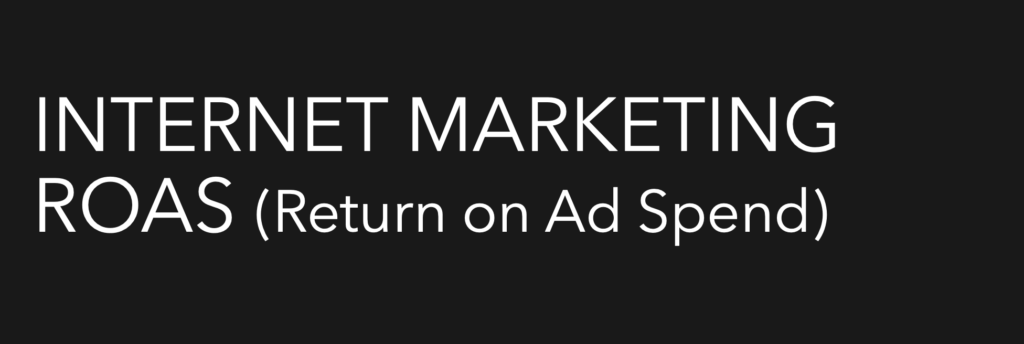
This article was originally posted by Jubilant Digital Marketing based on a keynote by David McBee
Spending money on advertising can be expensive and scary. Business owners want to know that the dollars they invest will result in sales. Luckily, digital advertising offers more transparency and attribution than has been available in the past.
In this article, we’ll discuss the mathematical equation to measure return on ad spend (ROAS), how to determine the minimum number of clients needed to consider an advertising campaign “successful” and we’ll discuss the realities of lagged revenue and determining closing rates of clicks, views, form completions and foot traffic.
Why a conversation about ROAS?
When businesses invest in traditional media, be it TV, radio, outdoor, print, sponsoring the local little league team, participating in a hometown parade, refrigerator magnets with the local sports team’s schedule… really anything that isn’t digital, what is normally the goal of those campaigns? More importantly, how do advertisers measure the success of those traditional advertising campaigns?
The business that puts their logo on those little league uniforms probably doesn’t really expect that someone watching the game will be motivated to come and buy from them, at least not immediately following the game.
Even the business that invests in that big billboard probably doesn’t think that people will pull over to the side of the road, write down their phone number and address, and then call or visit them immediately.
They understand that it’s unlikely that someone who sees their traditional advertising will take immediate action and that there is very little they can measure to prove the impact of the ads.
Even the business that has a big, fancy TV commercial knows that proving that the commercial is “working” is an insurmountable challenge.
So if traditional media doesn’t drive immediate action, and if the attribution of results is so ambiguous, why do advertisers invest in traditional media?
Brand awareness, right?
And what’s wrong with that? Not a thing. Brand awareness works. Plenty of advertisers have invested heavily in billboards and radio jingles so that their name and brand are top of mind when prospects are in need of their services. Brand awareness has been the goal of hundreds of advertising campaigns for hundreds of years.
But research shows that proving ROI (aka ROAS) is twice as important as brand awareness. (source: trackmaven)
So, while brand awareness is great, the transition to digital advertising provides ways of measuring actions like clicks, calls, web visits, store visits, form completions, and even e-commerce sales that all lend themselves to helping business owners to calculate the return on their ad spend and prove the value of their investment.
There’s actually a mathematical equation that is used to calculate ROAS and it all starts with CLV: Customer Lifetime Value. Once established, advertisers are able to determine exactly how many customers they need to make their advertising campaigns profitable.
By the way, 75% of North American senior executives care about customer lifetime value. (source: area systems) So if it’s important to senior executives, shouldn’t it be important to SMBs?
The ROAS mathematical equation
It all starts with AOV: Average Order Value, which is determined by taking the total revenue that a business makes in a year and dividing that by the number of orders fulfilled.
AOV: Average Order Value
—————————————-
Total Annual Revenue ÷ Total Orders = AOV
An advertiser we worked with who owns a party and equipment rental business was kind enough to go through this process and has given us permission to share his numbers in this article.
He did 2.1 million dollars in sales. He had 8700 orders. His AOV is $241.
The next part of the calculation is purchase frequency, determined by dividing the total number of orders by unique customers.
PF: Purchase Frequency
—————————————-
Total Orders ÷ Unique Customers = PF
Our rental friend’s books showed how many unique customers he served over the course of the year and he was able to calculate that his customers make 2.9 purchases per year.
The next step uses the results we’ve gotten so far to calculate customer value.
CV: Customer Value
—————————————-
AOV X PF = CV
The rental client’s customer value is calculated: AOV of $241 X PF of 2.9 = CV of $699
Next is customer average lifespan, which is determined by how many years the customer buys from the business. Admittedly, this may be the hardest piece to nail down accurately.
CAL: Customer Average Lifespan
—————————————-
Customer is loyal for how many years?
Our rental friend has some customers who rent from him only once. But he also has customers that have rented from him for years, even decades. He provided a conservative estimate of 5 years.
That leads us to the coveted CLV.
CLV: Customer Lifetime Value
—————————————-
CV X CAL = CLV
Here’s what the numbers look like in our rental example. CV of $699 X CAL of 5 = CLV of $3,495
Many businesses underestimate this, and that’s why it’s so important to do the math and run the numbers accurately. And by the way, if that seems high, consider that Starbucks ran these same numbers and discovered that their average customer lifetime value is $14,099! (Source: Source: Neil Patel)
But there’s a problem with stopping the math at CLV. CLV doesn’t account for all the expenses associated with a business. It doesn’t consider the cost of goods and services, payroll, taxes, etc. – all the expenses required to service a customer.
For that reason, business owners need to calculate the profit they make from their sales.
This provides CLP: Customer Lifetime Profit, a much more meaningful number for calculating ROAS. It can be determined by taking CLV: Customer Lifetime Value and multiplying it by the NPP: Net Profit Percentage of the sale.
A healthy business should be making a minimum of 15 to 20 percent profit, and really that should be closer to 40 to 50% profit. (Source: Source: smallbusiness.chron.com/)
CLP: Customer Lifetime Profit
—————————————-
CLV X NPP = CLP
Our rental friend estimated a conservative 15% NPP, making his CLP $525.
Here’s a recap of the abbreviations and their meanings, as well as our example results.
AOV: Average Order Value $241
PF: Purchase Frequency 2.9
CV: Customer Value $699
CAL: Customer Avg. Lifespan 5yrs
CLV: Customer Lifetime Value $3,495
NPP: Profit Percentage 15%
CLP: Customer Lifetime Profit $525
With all of this math completed, we are now able to calculate MCN200, possibly the most important goal that a business can use to measure the success of an advertising campaign.
MCN200 answers the question: “What is the minimum result to warrant the investment?”
MCN200
—————————————-
Minimum Customers Needed for a 200% ROAS
Or said another way, for every $1000 in advertising that a business spends, what is the minimum number of customers required for a $2000 return?
Can it be more than that? Will it be more than that? A lot of the time, yes. But 200% ROAS is a good minimum expectation for an advertising campaign.
Let’s consider our rental friend again. For every $1000 he invests in an advertising campaign he will need 4 new customers to earn a 200% ROAS. That doesn’t mean that’s all he can expect to get from his advertising campaign. He could easily reach a stretch goal of 7.6 customers for a 400% ROAS. It’s not unreasonable to think that a $1000 online marketing campaign would result in nearly 8 customers. At the end of the day, he should be reaching for an even greater return. But as long as the ROAS is greater than 200%, he can be confident that he is getting a much better return on his investment than the stock market produces.
Not a math person? Download the ROAS calculator here.
The next step in the process for calculating ROAS involves attribution. This is where it gets challenging to measure traditional advertising campaigns and digital has an advantage because there are a lot of elements of a digital campaign that can be tracked.
Clicks can be tracked. When someone clicks an ad, it’s fairly easy to track that click via Google, social media or even display ads. But that’s not the case for all digital strategies. For the most part, we can’t (or don’t) click streaming TV and audio commercials.
A metric often used with display, streaming TV, and radio campaigns is view-through. View through occurs when a display or video ad is delivered to a prospect; they are busy doing other things at the time of delivery so they don’t always stop and click it (and in the case of connected tv, they can’t click it). But with a little code placed on the advertiser’s website, we can see if that same device or any device in that home visits the website within 30 days of when they were delivered an ad, even if it’s not clicked in the moment.
It is also valuable to measure website engagement. Websites with submission forms or e-commerce can take advantage of this metric to determine when someone requests more information or places on an online order.
Phone calls can be tracked. With a special call tracking number in place, a business can measure if the people to whom they are delivering their ads pick up the phone and call them. Often this measurement captures the phone number of the caller or even records the conversation for additional insight or the ability to cross-reference to an actual sale that was made.
And for businesses utilizing geofencing as a tactic for driving foot traffic to a physical location, foot traffic can be measured.
It’s still not evidence that a sale has been made
With the exception of trackable e-commerce sales, it’s difficult for advertisers to prove that a click, a view through, or even foot traffic results in a sale.
This is where even the best digital campaign starts to feel a little bit like a traditional campaign, where the business owner has to do some research or estimating and they should understand that even with all of this tracking in place, there’s still an element of brand awareness that drives business and is not trackable.
The best way for an advertiser to close the gap on these metrics is for them to determine their closing ratios. Or said another way, “If ten people walk through the door, how many of them become customers?”
The answer to that question will, of course, vary greatly depending on the business. In a boutique that sells ladies clothing, maybe half of those who come in are window shoppers who don’t end up buying anything. Car dealerships may only close 1 in 10 of those tire kickers that come to their lots and look around. Restaurants probably close 10 out of 10 because once a person enters a restaurant, they’re probably not going to leave.
Businesses that want the most accurate ROAS need to know or estimate how many visits it takes for them to win a new client. Because when a campaign report shows that the campaign drove, say, 40 visits to their store, and they don’t believe that resulted in at least 4 new clients, then even an awesome calculator isn’t going to make them feel confident about their advertising campaign.
The same goes for web visits or form completions. It’s imperative to determine how many web visits or form completions it takes to result in an actual customer.
Aside: We worked with a doctor who wasn’t super sure his campaign was working, despite reporting that showed about 40 online requests for consultations every month.
He shared that about 8 in 10 of the people who completed the request form on his website ended up scheduling a consultation. And of those 8 consults, he could count on 2 becoming patients. His average customer lifetime profit came in around $4000 per patient. So when we suggested that winning one new patient from those 40 form completions would mean that his $2000 campaign was successful, he admitted that his expectations of the campaign were really a lot higher than that. He thought a $2000 advertising campaign was going to make his phone ring off the hook.
In reality, the campaign was killing it. Using his own math and closing ratio, 40 form completions would turn into about 8 patients, which blew away his MCN200 number of 1 patient.
But because he wasn’t booked out months in advance, he didn’t think the campaign was successful. Calculating ROAS helped him understand that the campaign was working and that if he wanted even more business, if he wanted to be booked out months in advance, then we should talk about increasing his budget.
Once he understood that all he really needed for his campaign to earn him a 200% ROAS was one patient, we never talked about whether or not the campaign was working. Instead, our conversations turned to how well the campaign was working and what stretch goals we were reaching. To this day, he continues to invest in that campaign, with confidence that his investment is resulting in more than enough new patients to warrant his investment in the advertising campaign.
Lagged Revenue
Because our calculation uses the lifetime value of customers, it requires some advertisers to wait on the profits.
Starbucks probably isn’t going to invest $7000 into a campaign that only results in one new customer, even if they are worth over $14,000 over the course of their lifetime. And most business owners are not going to be able to keep investing in a campaign that has to wait for five years of customer loyalty for them to earn a positive ROI.
It’s easy for the doctor to invest $2K/mo because when they get their new patient worth $4K, they’re already in the black. But if an average sale is only $241, as is the case with our rental friend, and only 15% of that is profit, and he has to wait for 5 years for their customer lifetime profit of $525, then the decision to continue advertising gets a little more perplexing.
Those first few months of the campaign could easily put an advertiser in the red, as they wait for the revenue to catch up. This is a term called Lagged Revenue, which is revenue coming from past campaigns that haven’t converted yet.
This happens a lot and is rarely tracked or talked about, but we’ve provided attribution reports to clients up to 60 days after they’ve canceled a campaign to show them foot traffic that is still converting, long after the campaign ended.
In the first few months of a campaign, the advertiser may not come out ahead. It may take time for the lagged revenue and repeat sales from new customers to catch up.
No, businesses should not continue to pour money into a campaign that isn’t creating a profit, but they also shouldn’t give up a campaign that is a little slow out of the gates but trending in the right direction.
This is where those stretch goals are nice. If the campaign is exceeding MCN200 right out of the gate, this conversation becomes null and void. But if it’s not, advertisers may have to have some patience and run the campaign long enough for the profits to catch up with the investment.
The ALWAYS ON campaign
Business owners will often say, “Oh I tried that strategy for two months and it didn’t work.”
It’s a lot like saying, “Oh, I tried that diet for two months and it didn’t work.”
Of course, it didn’t work. It was temporary from the start and so were the results. The people who don’t think of their diets as temporary are the ones that have lasting success. They make a lifestyle change, deciding to exercise regularly and they make healthier eating choices. They aren’t “trying out” something that will have an ending date. Instead, they shift their paradigm to a different way of thinking.
Advertisers who realize that a digital advertising campaign takes some time to gain momentum, to be optimized for success, and will ultimately become a permanent solution for their new client acquisition are more apt to have success long term.
So, the answer to “How long should I run my campaign?” can be answered with a question of its own: “How long do you want to make people aware of your business and win new clients?”
Perhaps the only reason for a business not to advertise is because it has more customers than it can keep up with. And even then, a solid branding campaign that can help keep the business top of mind, isn’t out of the question.
It’s clear from this article that digital campaigns offer attribution elements unknown to their traditional counterparts and that there are ways to determine the success of those campaigns by measuring ROAS.
It’s also clear that this is an imperfect solution. Some of the elements required for an accurate calculation may have to be estimated. That means that the results will also be estimates.
Add to that the impossible task for determining an accurate closing rate (based on web or foot traffic), and the concept of lagged revenue, and the house of cards becomes even less stable.
Still, when we’ve seen advertisers use this method to measure the impact of their advertising campaigns, the results normally far exceed the MCN200 goal and, even with some estimated ingredients in the recipe, provide the advertiser with the confidence that they are making more profits on their advertising campaigns than they are investing in them. And isn’t that the ultimate goal, after all?
Thanks for reading, David McBee
Contact Jubilant today for your free internet presence audit.
Contact David McBee for an internet marketing keynote presentation.


